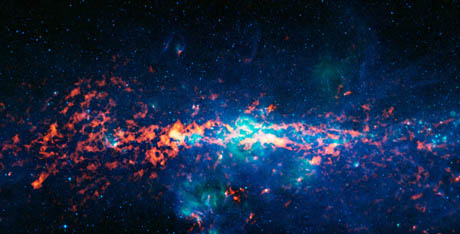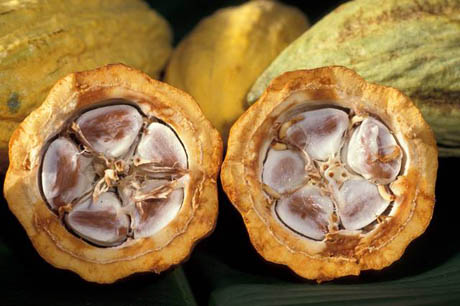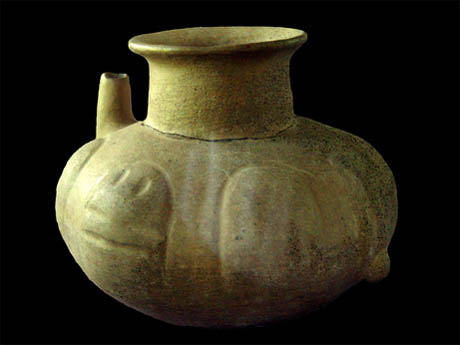
IMAGE: Dogfish Head’s Theobroma next to Patrick McGovern’s Uncorking the Past.
With just a few hours left in this apartment, and much yet to be packed, it’s time to crack open the bottle of Dogfish Head’s Theobroma beer that has been lingering in the fridge, futilely awaiting an occasion when my taste buds and typing fingers feel — simultaneously — ready to do it justice.
The beer is one of the Delaware brewery‘s “liquid time capsules”: it was created in collaboration with biomolecular archaeologist Patrick McGovern who, according to his University of Pennsylvania webpage, is “known as the ‘Indiana Jones of Ancient Ales, Wines, and Extreme Beverages.’”
McGovern’s enjoyable book, Uncorking the Past, begins with an amazing image: apparently, astronomers have used radio-waves to discover “massive clouds” of alcohol, “measuring billions of kilometers across,” scattered throughout interstellar space, “surrounding new star systems.” While he hints at a thrilling future of human “extraterrestrial ethanol” exploitation, McGovern’s primary interest is in the role alcohol played in ancient civilisation — and perhaps at the dawn of human life.

IMAGE: Colour-composite image of the Galactic Centre and Sagittarius B2 from the European Southern Observatory. Sagittarius B2 is a vast cloud of interstellar particles including alcohol in the form of methanol, ethanol, and vinyl ethanol.
Thus, when McGovern read an article by anthropologist John Henderson in the Cornell alumni newsletter describing trace residues of an unidentified beverage on ancient Mesoamerican pottery fragments, his interest was piqued.
The jars and bowls in question dated back to 1400 B.C., a time when Linear A was the popular alphabet of the Mediterranean, and Homer had yet to be born. The vessels had been excavated from Puerto Escondido in modern-day Honduras, in an area called the Ulúa Valley, known (according to records from the sixteenth century, when the Spanish invaded) for its excellent cacao. Henderson’s theory was that the people of Puerto Escondido had been among the earliest to domesticate Theobroma cacao, and that the pottery fragments he had found might once have contained a “frothy chocolate beverage.”
A couple of email exchanges later, and Patrick McGovern was collaborating with John Henderson (and chemist Jeffrey Hurst of chocolate giant Hershey Foods) to analyse the drinking vessels. As he reports in Uncorking the Past, “Either John had an eye for picking out chocolate vessels or Puerto Escondido was awash in cacao. Eleven of the thirteen pottery sherds tested positive for the fingerprint compound of cacao, theobromine.”
In other words, McGovern’s team had found the earliest known evidence for an “unadulterated alcoholic beverage made from sweet cacao pulp” — a ceremonial drink made from the fermented fruit that we now discard in favour of the chocolate-producing bean it surrounds.

IMAGE: A cacao pod, cut in half to show the beans and pulp, via.
Plain cacao alcohol is “an abundant liquor of the smoothest taste, between sour and sweet, which is of the most refreshing coolness,” according to early Spanish records quoted by McGovern. Later, Mayans switched to using the bitter, chocolate beans as the base for an elite beverage whose flavour was usually “improved” with honey, maize, chilli, annatto, and vanilla. It was apparently served with a thick head of foam, in vessels designed so that “one had the option to inhale the foam or drink directly from the mouth of the vessel.”

IMAGE: A chocolate-containing “teapot” from Puerto Escondido, photography by John S. Henderson. According to McGovern, “Conceivably, the awkward-looking teapots might have been used in an earlier period to create a foam by blowing air through the spout or stirring the beverage vigorously through the main opening. As the foam rose through the spout, one had the option to inhale the foam or drink directly from the mouth of the vessel.”
Not satisfied with simply gathering biomolecular evidence, McGovern then wondered what such a drink might have tasted like. As he admits early on in his book, we can never be sure how close to reality any reconstruction is, since “ancient fossils tell us nothing about the easily degradable sensory-organ tissues,” and thus “early hominids might have had much more acute senses than ours, like the macaque, which has exquisite sensitivity to alcohol and other smells.”
Nonetheless, in a section of his book titled “Theobroma for the Masses,” McGovern describes his collaboration with Dogfish Head craft brewers Sam Calagione and Bryan Selders to create a beer based on the core ingredients of early New World alcohol: chocolate beans (in nib form, as the cacao pods are too perishable to transport from Honduras to Delaware), honey, corn, ancho chillis, and annatto. McGovern adds:
We might also have tossed in peppery “ear flower” or a hallucinogenic mushroom if they had been available. The fermentation was carried out with a German ale yeast, which is not obtrusive and brings out the flavours of the other ingredients.
The result? Cloudy and quite strong (9% A.B.V.), but more refreshing than you would think: the chocolate is savoury rather than sweet, and the chilli is just a very subtle, almost herbal, aftertaste. There is almost no head, which is just as well, as I’ve already packed my special froth-inhalation equipment, and so far, no ritual human sacrifice has been required (that may change as the night wears on).
Seriously, though, I love the idea of speculative archaeo-brewing. Of course, ancient flavours are undoubtedly completely lost to us today: the ingredients, our sensory receptors, and our palates have changed beyond recognition. But trying to recreate long-lost beverages not only helps you form scenarios about how they might originally have been made, it also prompts you to think in interesting ways about ingredients, geography, and the evanescence of taste.
And it helps you avoid packing.
Comments
6 responses to “Archaeo-alcohology”
I think it was Theobroma that I tried at a beer festival back in October, and I remember not really being all that impressed. It wasn’t awful, mind you, and it probably isn’t so bad as long as you’re not thinking it’ll resemble normal beer, but I remember thinking it was just too bizarre. I love the concept, though, and it’s definitely worth the effort no matter how it tastes.
As much as we could all thank Fritz for what he’s done, the idea of appending information about pioneers in a field to every feature article about something specific in the topic is laughable at best.
Re: Anonymous [Anchor Steam]
I think this is the Fritz Maytag reference Anon. has in mind –
http://www.anchorbrewing.com/beers/specialprojects.htm
Look closely at Dogfish Head’s web site. They have a “beer locator” map for their outlets. There are many in the SF Bay Area.
I’m wondering if this is actually an authentic reproduction. Many ancient cultures didn’t isolate yeast for fermenting beverages, and the fermentation’s had both yeast and lactic acid producing bacteria, which would result in a less alcoholic brew with more of a sour bite.
Well written! I have only been able to try the Midas Touch based on the beer remnants found from ancient Babylon and am dying to try some of the others. One question, though: if beer = win, and chocolate = win, then is a chocolate beer win x 2 or win squared?
You really should mention the role of Anchor Brewing and Fritz Maytag in starting this phenomenon.